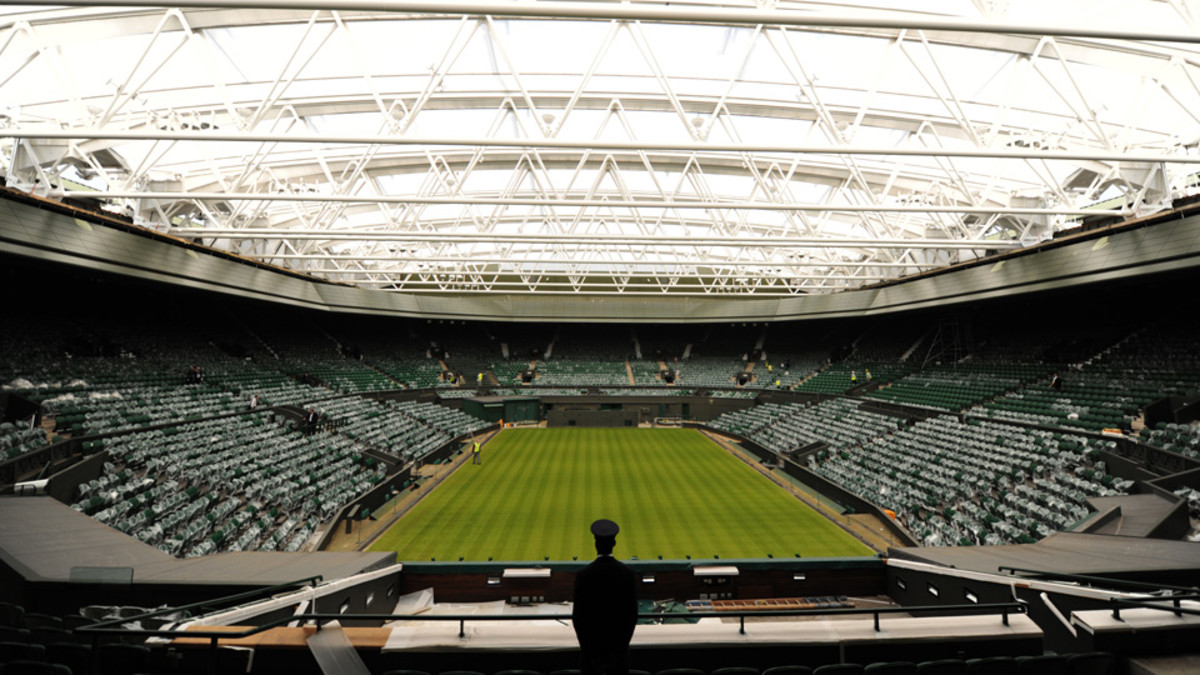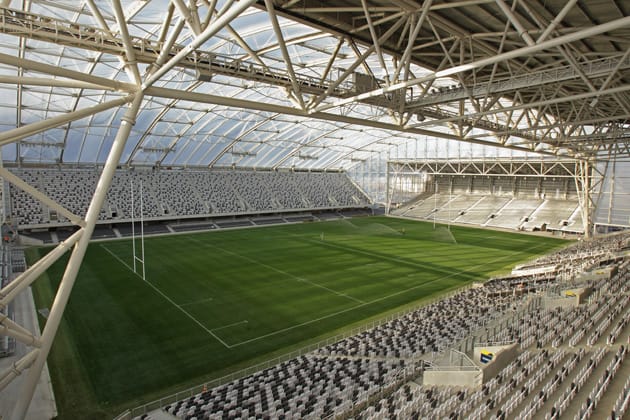Pop the top: The future of retractable roofs
When it comes to sports venues, Retractable roofs are, well, a weighty issue. So weighty, in fact, that the current USTA Arthur Ashe Stadium in Flushing Meadows couldn't structurally support such an addition without a complete rebuild or improved roof technology—though cover from the elements was sorely needed. Rain has played havoc with the two-week tournament's schedule in recent years, moving the men's final from Sunday to Monday more than once (dropping television rates to all-time lows in the process) in the last five years. The USTA had simply waved the weatherman's white flag, scheduling the men's final for Monday in 2013. No roof? Plan for plenty of rain.
But not any longer. The USTA has ambrace the current trend and now plans for a fabric roof to keep players dry. At Wimbledon, where the naked fescue and ryegrass lie exposed to natural light and elements, those elements turn liquid and wash away entire days of matches, undercutting ticket sales and frustrating highly lucrative television partners—ESPN pays $41 million annually to show live events, not rain-delayed replays, from Wimbledon. Beginning in 2015, the network will pay $75 million annually to televise the Open.
There's a simple remedy to all this, of course, and it's to put a roof overhead. A movable roof gives the option of both welcoming the natural elements and blocking them. Wimbledon first covered Centre Court in 2009, and the All England Club has plans to retractably cover Court 1 by 2019. The roofs aren't cheap—Centre Court's retrofit, designed by the international firm Populous, was about $150 million and who knows the cost for Court 1 five years from now—but having even one roof ensured non-stop tennis in London and kept primetime semifinal and final matches in regularly scheduled programming slots.

An aerial view of the All England Lawn Tennis & Croquet Club with the Centre Court roof closed for the first time during The Wimbledon Championships 2009.
AELTC
But don't think tennis is the only sport—or the one with the most money at stake—fretting about retractable roofs. As baseball, soccer and, especially, football stadiums grapple with the idea of movable roofs, owners must weigh the price of rain. And, more often, the cost of sunshine. Every owner wants it all: a mega-stadium open to the wonders and natural beauty of the area, but also an architectural marvel able to clam up tight when those wonders get uncomfortable, whether too wet or too hot. But the only way to have your open-air cake and dome it too is to spend millions to move a roof. With fans' comfort range so tight, our roofs keep closing anyway, turning what could be a $100 million investment into an expensive chunk of steel that just happens to occasionally slide. Maybe there's actually a right and wrong place to build a movable roof.
Nick Reynolds, Populous architect and designer of Wimbledon’s movable roof, says that 10 years ago steel retractable roofs were installed almost as a matter of course. Typical retractable steel roofs—with added engineering, materials and structure to support weight—add roughly a five percent surcharge to your project. An after-market addition, such as for Arthur Ashe Stadium, though, could easily top $100 million, even for that relatively small venue. During eras when a stadium set you back a mere $250 million, a surcharge wasn’t as foreboding. As football stadiums top $1 billion, that cost isn’t minimal. Just ask taxpayers.
"The moving roof is one thing,” Reynolds warns. “Normally, to get the full benefits, you have to tie in with a moving pitch, flexible louvers to increase ventilation, additional mobile UV lamps to assist the growth of the grass. You have to think about these things as a bit of a jigsaw.”
We can blame the trend to fret about rain on us, the fickle television viewers who’ll never come back to an event if delayed, especially in grand slam tennis or baseball.
“Event continuity in the age of 24-hour international broadcasting, the demands of sponsors and competition from new markets means that retractable roofs may become an even more regular feature of future stadia,” says Populous' Tom Jones, one of the designers of London’s roofless Olympic Stadium.
But rain doesn't stop soccer or football, where we see the most expensive stadiums in the world and the largest roofs. In baseball and tennis we want both to avoid rainouts and to protect against heat—three of baseball's six movable roofs are solely to combat heat, not rain. In football, roofs close in order to host non-sporting events, concerts and conventions that bring added revenue to the building's owners. The dual-use nature of the venue was cause for the retractable roof's rise, but also proves our love for keeping it closed.
Peter Eisenman, architect of University of Phoenix stadium, where the roof stays closed so much he designed a giant tray loaded with playing-surface sod to pull into the parking lot for natural growth, says retractable-roof thinking should be a thing of the past. “I think the retractable roof is a nuisance, to be honest,” he says. “The Cardinals hardly use it. The spectators don’t like the sun on them and I think it a waste of money.”
Super Sod: Designed to Outperform the Elements, World Cup Athletes
In cold-weather climates the window in which fans want exposure to natural weather is so narrow that “movable roofs are not going to be the style of the day” and simply constructing large overhangs—popular in European stadiums and similar to what the Seahawks did in Seattle by covering 70 percent of all CenturyLink Field fans—does enough to protect patrons from pelting rain and snow. If fans are dry, they’re happy, Eisenman says.
The NFL has four retractable roofs—Indianapolis, Dallas, Houston and Phoenix—with another planned for Atlanta. Those roofs are closed for nearly 70 percent of NFL games played within, though. Worth the cost?
Bryan Trubey, HKS architect and designer of new NFL retractable-roof stadiums for the Cowboys and Colts and a planned new building—with a fixed translucent roof—for the Vikings says it is surprising how many stadiums have a retractable roof where it doesn’t make sense. And that coming from the man who designed half the retractable roofs in the NFL.
Building a permanent roof makes sense for football venues desiring non-stop events. Opening up to the elements has a draw for those not as concerned with rain or heat. The retractable roof doesn't have a defined place in football or soccer. And baseball doesn't fare much better. The stats show the roofs remain closed roughly three-fourths of the time in warm MLB climates and close only about a quarter of the time in the rain-threatened Pacific Northwest. Us fans, we like the modern comforts of air conditioning. Sixty-eight degrees and artificially sunny always feels nice. Rainouts do prove a real threat, snarling an already-tight baseball schedule with high-cost makeup dates upsetting fans who have spent hundreds of dollars to attend a game and throwing off pitching rotations when double-headers arrive. Rescheduling 20 or more Mariners games would turn nightmarish. But closing the roof for the sun in Phoenix, Miami and Houston? That practice doesn't make financial sense.
For those venues that fall into the narrow window in which a retractable roof makes sense, fresh options exist. The emergence of lightweight fabrics—ETFE and Teflon are proving popular—can drop hulking steel roof costs and give owners new taxpayer-friendly choices in keeping turf growing outdoors and the climate controlled indoors under a retractable roof. In Vancouver, BC Place has a retractable fabric roof that even folds into a centerhung scoreboard
The translucent nature of the fabric also lets in natural light, even with a closed roof, so fans get a truer outdoor experience and move away from the dome experience. In Atlanta, 360 Architecture will do just this, with a never-before-done retractable design for the new Falcons’ stadium that uses eight moving panels that open in a pinwheel-like manner. There, designers have turned the roof into a showpiece. And when closed, the material’s opaqueness can be fully controlled to let in more or less light.
In New Zealand, meanwhile, in what could be described as a designer's moving heaven and earth—but not a roof—to accommodate a seemingly impossible requirement, Reynolds employed ETFE fabric to create Forsyth Barr Stadium, the first fully enclosed stadium with natural turf.
Tim Newcomb covers stadiums, design and gear for Sports Illustrated. Follow him on Twitter at @tdnewcomb







